


xxxxxJosiah Wedgwood learnt his
trade in his father's pottery and made a special study of the
ceramic materials, pigments and glazes. He opened his own business
at Burslem, Staffordshire, in 1760, and,
by using a harder version of cream-
JOSIAH WEDGWOOD 1730 -
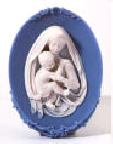
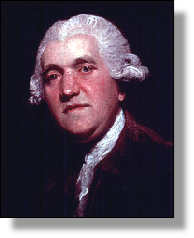 xxxxxJosiah Wedgwood was born in Burslem,
Staffordshire, and, from the age of nine worked in the family pottery.
An ambitious and highly enterprising young man, in 1760
he set up his own business at the Ivy House Factory, and quickly
gained a reputation for the high standard of his workmanship and the
much improved quality of his materials. Inquisitive by nature and with
a scientific turn of mind, he was for ever experimenting with and
developing a whole new range of ceramic materials, pigments and
glazes. Herein was to lie the major reason for his remarkable success.
xxxxxJosiah Wedgwood was born in Burslem,
Staffordshire, and, from the age of nine worked in the family pottery.
An ambitious and highly enterprising young man, in 1760
he set up his own business at the Ivy House Factory, and quickly
gained a reputation for the high standard of his workmanship and the
much improved quality of his materials. Inquisitive by nature and with
a scientific turn of mind, he was for ever experimenting with and
developing a whole new range of ceramic materials, pigments and
glazes. Herein was to lie the major reason for his remarkable success.
xxxxxIt was while working at Ivy
House that he produced a much harder version of cream-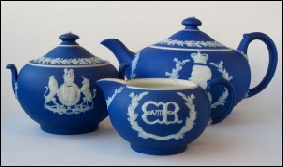 rising
middle classes that he had to take over Brick House, another factory
nearby, in order to cope with the demand. In the years to come,
Wedgwood was to produce an immense variety of pottery shapes and
designs, but it was this early creamware, tasteful in shape and
decoration and highly durable, which was to be his great money
spinner, attracting as it did huge markets both at home and
overseas. Suffice it to say that in 1775 he produced a 952 dinner
service for Catherine the Great of Russia!
rising
middle classes that he had to take over Brick House, another factory
nearby, in order to cope with the demand. In the years to come,
Wedgwood was to produce an immense variety of pottery shapes and
designs, but it was this early creamware, tasteful in shape and
decoration and highly durable, which was to be his great money
spinner, attracting as it did huge markets both at home and
overseas. Suffice it to say that in 1775 he produced a 952 dinner
service for Catherine the Great of Russia!
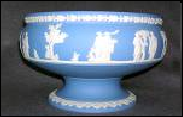 xxxxxIn
1768 he built a new factory near Stoke-
xxxxxIn
1768 he built a new factory near Stoke-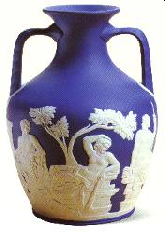 tral
Italy where classical vases had been recently discovered. This new
departure was based on his development of jasperware, so named because
it was hard like the rock. This durable, unglazed porcelain could be
stained in a variety of colours and decorated with white relief
figures and scenes of neo-
tral
Italy where classical vases had been recently discovered. This new
departure was based on his development of jasperware, so named because
it was hard like the rock. This durable, unglazed porcelain could be
stained in a variety of colours and decorated with white relief
figures and scenes of neo-
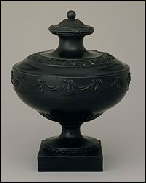 xxxxxHe also perfected a black stoneware called
basalt, making a great improvement upon the stained earthenware
hitherto known as "Egyptian black". This enabled him to produce
candlesticks, vases and plaques for interior design, and a wide
variety of jewellery like cameos, bracelets and rings, as well as
life-
xxxxxHe also perfected a black stoneware called
basalt, making a great improvement upon the stained earthenware
hitherto known as "Egyptian black". This enabled him to produce
candlesticks, vases and plaques for interior design, and a wide
variety of jewellery like cameos, bracelets and rings, as well as
life-
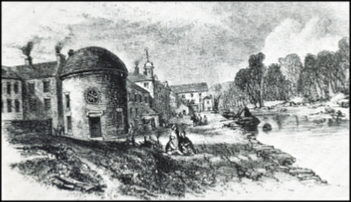 xxxxxBut Wedgwood was not merely a pottery
designer and manufacturer of remarkable skill. He was also an astute
businessman and an able scientist. His factory at Etruria (illustrated)
was designed "with a view to the strictest economy of labour". As
such, production was on the lines of the future "conveyor belt"
system, in which workers specialised in a particular skill and the
product itself "moved on". And, with the introduction of "transfer
printing" on pottery -
xxxxxBut Wedgwood was not merely a pottery
designer and manufacturer of remarkable skill. He was also an astute
businessman and an able scientist. His factory at Etruria (illustrated)
was designed "with a view to the strictest economy of labour". As
such, production was on the lines of the future "conveyor belt"
system, in which workers specialised in a particular skill and the
product itself "moved on". And, with the introduction of "transfer
printing" on pottery -
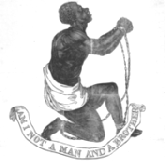 xxxxxAs we shall see, Wedgwood also played an
important part in social reform. In 1787, together with Granville
Sharp and the English cleric Thomas Clarkson, he formed a society for
the abolition of the slave trade. It was this society which, using
William Wilberforce as their spokesman in parliament, succeeded in
persuading the then prime minister, William Pitt, to set up an
investigation into the slave trade. Illustrated here is the society's
seal, designed and made by Wedgwood. It reads: "Am I not a man and a
brother?"
xxxxxAs we shall see, Wedgwood also played an
important part in social reform. In 1787, together with Granville
Sharp and the English cleric Thomas Clarkson, he formed a society for
the abolition of the slave trade. It was this society which, using
William Wilberforce as their spokesman in parliament, succeeded in
persuading the then prime minister, William Pitt, to set up an
investigation into the slave trade. Illustrated here is the society's
seal, designed and made by Wedgwood. It reads: "Am I not a man and a
brother?"
xxxxxFollowing the death of Wedgwood in 1795, the business continued to thrive, despite growing competition as time went by. In the early years of the 19th century, for example, the company supplied a 1,300 piece dinner service to the White House during the presidency of Theodore Roosevelt. In 1940, during the Second World War, Etruria was finally closed down and a modern factory opened at Barlaston, Staffordshire.
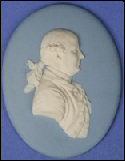 xxxxxWellxworthy of mention is Wedgwood’s able business
partner Thomas Bentley (1730-
xxxxxWellxworthy of mention is Wedgwood’s able business
partner Thomas Bentley (1730-
xxxxxIncidentally,
when Wedgwood was in his early teens he lost his right leg as a
result of catching smallpox. This is one of the reasons -
xxxxx…… The famous English naturalist Charles Darwin was the grandson of Josiah Wedgwood. His mother, Susannah Wedgwood was the daughter of the pottery designer and manufacturer.
Including:
Sèvres
Porcelain

Acknowledgements
Wedgwood: by the
English portrait painter Joshua Reynolds (1723-
G3a-
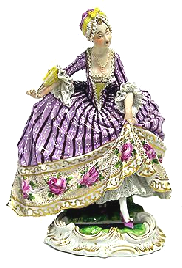 xxxxxAs noted above, one of the European pottery
manufacturers which was keenly affected by the competition from
Etruria was the French ceramic industry at Sèvres
in south-
xxxxxAs noted above, one of the European pottery
manufacturers which was keenly affected by the competition from
Etruria was the French ceramic industry at Sèvres
in south-
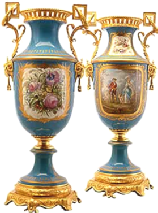 xxxxxThe king took over the factory in 1759, and
two years later the secret of making hard paste porcelain (porcelaine
royale) was discovered, or rather bought. However, it was not
used extensively until the early 1770s, when the required raw material
was found nearer home in the Périogord district. Some of the dinner
services at this time were decorated with birds copied from the book The Natural History of Birds,
the outstanding work by the French naturalist George Buffon. Fashionable too was porcelain in the distinctive
styles of Louis XV and XVI, but with the coming of the French
Revolution the industry was badly hit, and the factory struggled to
survive. However, the 19th century saw a number of technical
innovations, together with the introduction of a better quality hard
paste, and this brought about a marked recovery, led by the Neo-
xxxxxThe king took over the factory in 1759, and
two years later the secret of making hard paste porcelain (porcelaine
royale) was discovered, or rather bought. However, it was not
used extensively until the early 1770s, when the required raw material
was found nearer home in the Périogord district. Some of the dinner
services at this time were decorated with birds copied from the book The Natural History of Birds,
the outstanding work by the French naturalist George Buffon. Fashionable too was porcelain in the distinctive
styles of Louis XV and XVI, but with the coming of the French
Revolution the industry was badly hit, and the factory struggled to
survive. However, the 19th century saw a number of technical
innovations, together with the introduction of a better quality hard
paste, and this brought about a marked recovery, led by the Neo-
xxxxxOne of the leading pottery
manufacturers which suffered from Wedgwood competition was the Sèvres works in Paris. This
industry was first established at Vincennes in 1738 and moved to
Sèvres in 1756, by which time the soft-
xxxxxOther French factories at
this time were located at Chantilly, Mennecy and Limoges -
xxxxxIncidentally, you may remember that a work by the 17th century Dutch artist Jacob Van Ruisdael entitled Le Coup de Soleil was used by the Sèvres factory around 1836 as a motif on some of its porcelain. The painting shows a burst of sunlight breaking through the clouds and illuminating the river below.



